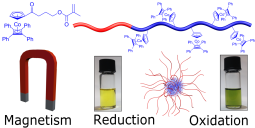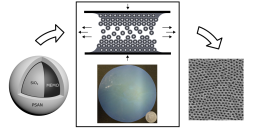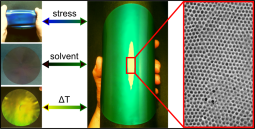Back cover for our article
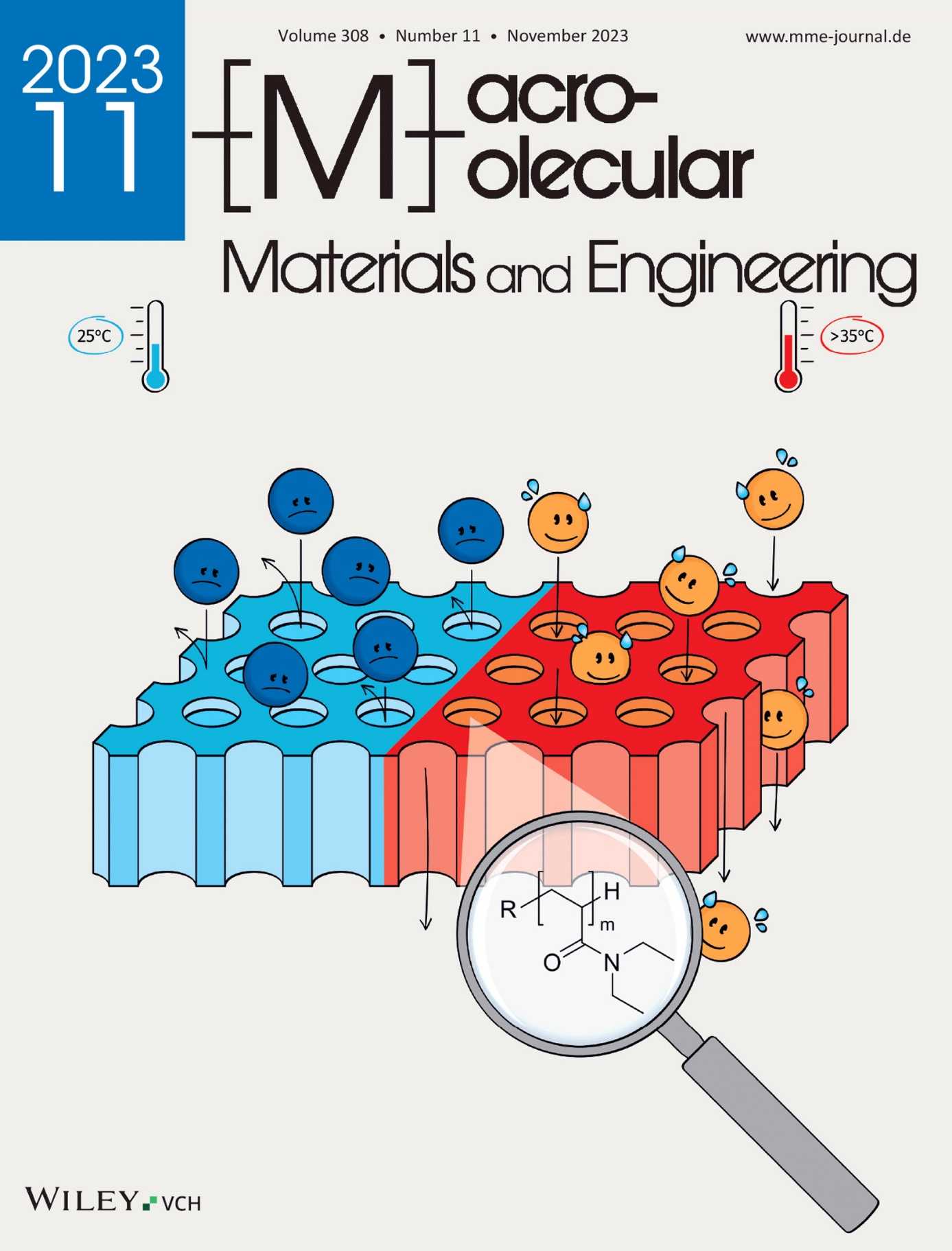
Thermo-Responsive Ultrafiltration Block Copolymer Membranes Based on Polystyrene-block-poly(diethyl acrylamide) published in Wiley Macromolecular Materials and Engineering 2023, 308, 2300113. DOI: 10.1002/mame.202300113
In article 2300113 by Markus Gallei and co-workers, a thermo-responsive ultrafiltration membrane is prepared based on polystyrene-block-poly (diethyl acrylamide) synthesized by means of “living” anionic polymerization. The membranes are fabricated using the non-solvent-induced phase separation (NIPS) process exhibiting up to a 23-fold increase for the water permeance when crossing the lower critical solution temperature of the poly(diethyl acrylamide) block segment in water.
Chemists develop sustainable method to remove 'forever chemicals' from water
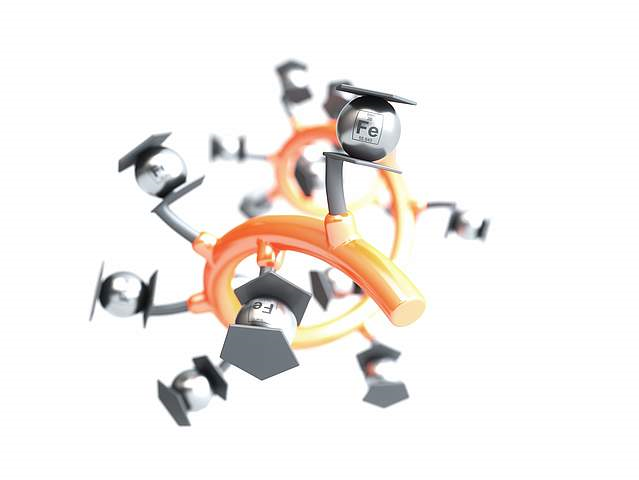
PFAS – per- and polyfluorinated substances – are man-made chemicals that are widely used because of their waterproofing, stain-resistance and grease-repelling properties. Thousands of different kinds of PFAS compounds are in use in a huge range of products, from cooking pans and outdoor clothing to cosmetics and firefighting foams. But it is these very same properties that have made PFAS into a huge environmental problem. Their chemical and thermal stability means that they cannot be broken down by any naturally occurring process. Polymer chemists from Saarland University and the University of Illinois at Urbana-Champaign (USA) have collaborated to develop a sustainable method of removing PFAS from water.
Their work has been published in the journal
PFAS are highly versatile chemicals. These fluorine-containing organic molecules are the reason why rain drops simply slide off outdoor jackets. They are used in the greaseproof coating of paper food packaging and are key ingredients in fire-extinguisher foams and the protective gear worn by firefighters. PFAS were first introduced in the 1940s and since then, the number of products and areas in which they are used has grown astronomically.
And that's where the problem lies. Because they are so inert and there are no natural pathways by which they can be broken down, these highly persistent chemicals accumulate in the natural environment – posing a problem for human health and the environment. PFAS have now been detected all over the planet: in water, soil and air, in plants, animals and – at the end of the food chain – in humans, too. Just how much of a health risk these chemicals pose is still not clear. Initial laboratory animal studies have shown that PFAS may impair reproductive health. What is clear is that these synthetic compounds do not belong in the natural environment and certainly not in living organisms. It therefore makes sense to find ways to try and reduce PFAS contamination levels in the environment.
But PFAS remediation is both complex and challenging, and the processes used can themselves have a detrimental impact on the environment and the climate. And before they can be removed, the PFAS have to be detected. Detection is not made any easier by the fact that only small quantities of PFAS are required for a large effect (e.g. the ultra-thin coatings in food packaging). Conventionally, PFAS have been removed from water by filtration using special membranes or lower-cost activated carbon adsorbents. However, recovering the PFAS from these filter systems so that they can be permanently destroyed either requires the use of harsh chemical conditions or incineration.
At least that has been the case up to now. A team of researchers led by Markus Gallei, Professor of Polymer Chemistry at Saarland University, Professor Xiao Su from the University of Illinois Urbana-Champaign, and their doctoral students Frank Hartmann (Saarland) and Paola Baldaguez (Illinois) have developed a new electrochemical method that can remove PFAS chemicals from water and then efficiently release them again for destruction. This new PFAS remediation platform allows these fluorinated contaminants to be collected, identified and then destroyed without needing to incinerate the filter.
In the method developed by the research team, the central role is played by metal-containing polymers known as metallocenes. Metallocenes first came on the scene in 1951 with the discovery of the iron-containing molecule ferrocene. Since then, many other metallocenes have been reported. Frank Hartmann, Markus Gallei and their international team have found that electrodes functionalized with ferrocene or – even more effectively – with a cobaltocene synthesized by Frank Hartmann, are able to remove even minute quantities of PFAS molecules from water.
But the real key lies in the fact that if a voltage is applied to the ferrocene or cobaltocene metallopolymers, they can 'switch' their electrical state and release the PFAS molecules previously captured. 'And cobalt is significantly better at doing this than iron,' observed Frank Hartmann. 'We've found a means by which PFAS can be efficiently removed from water and then released again, effectively regenerating the electrode for further use. Unlike the activated carbon filter, which I have to destroy once it has become saturated with PFAS molecules, I can switch the metallocenes a thousand times, should I want to,' said Markus Gallei, summarizing the significance of the research work.
Having laid the foundations, Frank Hartmann, Markus Gallei and their colleagues at the University of Illinois are now looking to upscale development to facilitate the removal of these highly persistent contaminants from our rivers and oceans.
Original publication:
Investigating the Electrochemically Driven Capture and Release of Long-Chain PFAS by Redox Metallopolymer Sorbents
Paola Baldaguez Medina, Valentina Ardila Contreras, Frank Hartmann, Deborah Schmitt, Angelique Klimek, Johannes Elbert, Markus Gallei, and Xiao Su
ACS Applied Materials & Interfaces 2023 15 (18), 22112-22122
DOI: 10.1021/acsami.3c01670
German Version:
Chemiker entwickeln Methode, um gefährliche Substanzen nachhaltig aus dem Wasser zu entfernen| Universität des Saarlandes (uni-saarland.de)
Further information:
Frank Hartmann
Tel.: +49 681 302-71310
Email: frank.hartmann@uni-saarland.de
Pro. Dr.-Ing. Markus Gallei
Tel.: +49 681 302-4840
Email: markus.gallei@uni-saarland.de
Web: www.gallei-lab.com
 |
 |
Special Colloquium | Prof. Markus Gallei (Universität des Saarlandes) | Stimuli-Responsive Polymer Architectures as Optical Sensing Materials and Smart Membranes
Talk@Albert-Ludwigs-Universität Freiburg in the framework of the LivMats Cluster of Excellence (Living, Adaptive and Energy-autonomous Materials Systems)
Abstract
In the last decade stimuli-responsive polymers attracted enormous attention for a range of important applications. Such polymers are capable of changing their conformation, solubility, or they can even break or form covalent bonds upon a change of temperature or pH value, upon light irradiation, by using electrochemical stimuli or by the presence of an electrical or magnetic field, or by combinations thereof. The presentation will focus on polymer materials, which contain at least one selectively addressable segment, either chemically or physically. Functional porous nanostructures obtained by block copolymer self-assembly as well as recentadvances in inverse opal films prepared by using the so-called melt-shear organization technique will be highlighted and discussed in more detail. In the case of soft colloidal crystal and inverted structures, which are also referred to as polymeric opals, external triggers additionally lead to a remarkably fast and reversible change of their intriguing optical properties, which could be easily processed to films or 3D printed complex objects. A major benefit of self-assembled polymeric materials is their inexpensive and convenient preparation giving a good optical performance. The talk will give some recent advances for the rational design of functional porous materials with hierarchical architectures also in combination with sustainable cellulose-based materials. Herein presented preparation strategies will pave the way to a manifold of applications in the field of sensing and smart membrane technologies.
Full abstract with references/graphics
01. June 2023
Thursday 16:00 pm - 17:00 pm FIT seminar room
Meet Us @ Macromolecular Colloquium 2023 in Freiburg
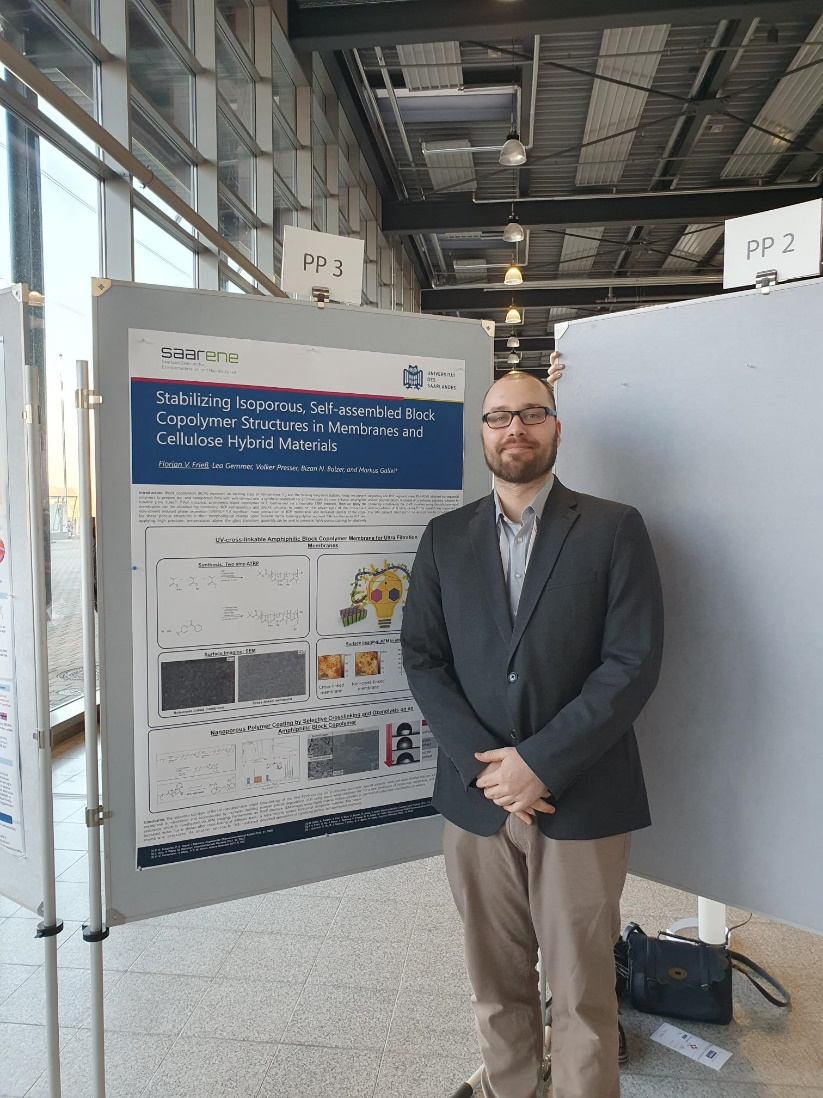
At this year's Macromolecular Colloquium in Freiburg the working group is represented with a poster contribution.
The work by Florian Frieß – published in Macromolecular Rapid Communications (Nanoporous Block Copolymer Membranes with Enhanced Solvent Resistance via UV-Mediated Cross-Linking Strategies, Macromolecular Rapid Communications 2022. 43(3), 2100632. DOI: 10.1002/marc.202100632) deals with the UV-mediated cross-linking reaction within the matrix of isoporous block copolymer membranes for enhanced stabilization and increased performance within ultrafiltration experiments.
In a world-first, chemists from Saarland University print complex structurally coloured 3D objects
Have you ever looked at a butterfly or an iridescent opal and noticed how the shimmering rainbow colours you see change depending on how light falls onto the insect or gemstone? This fascinating play of rainbow colours is purely down to the microscopically structured surface of these objects and is not produced by dyes or pigments, which are frequently toxic and may fade with time. Up until now, such structural colours could only be manufactured as thin films. Chemists Lukas Siegwardt and Markus Gallei from Saarland University have now found a way to print complex three-dimensional objects that exhibit brilliant structural colouration.
They have published their method in the highly respected journal
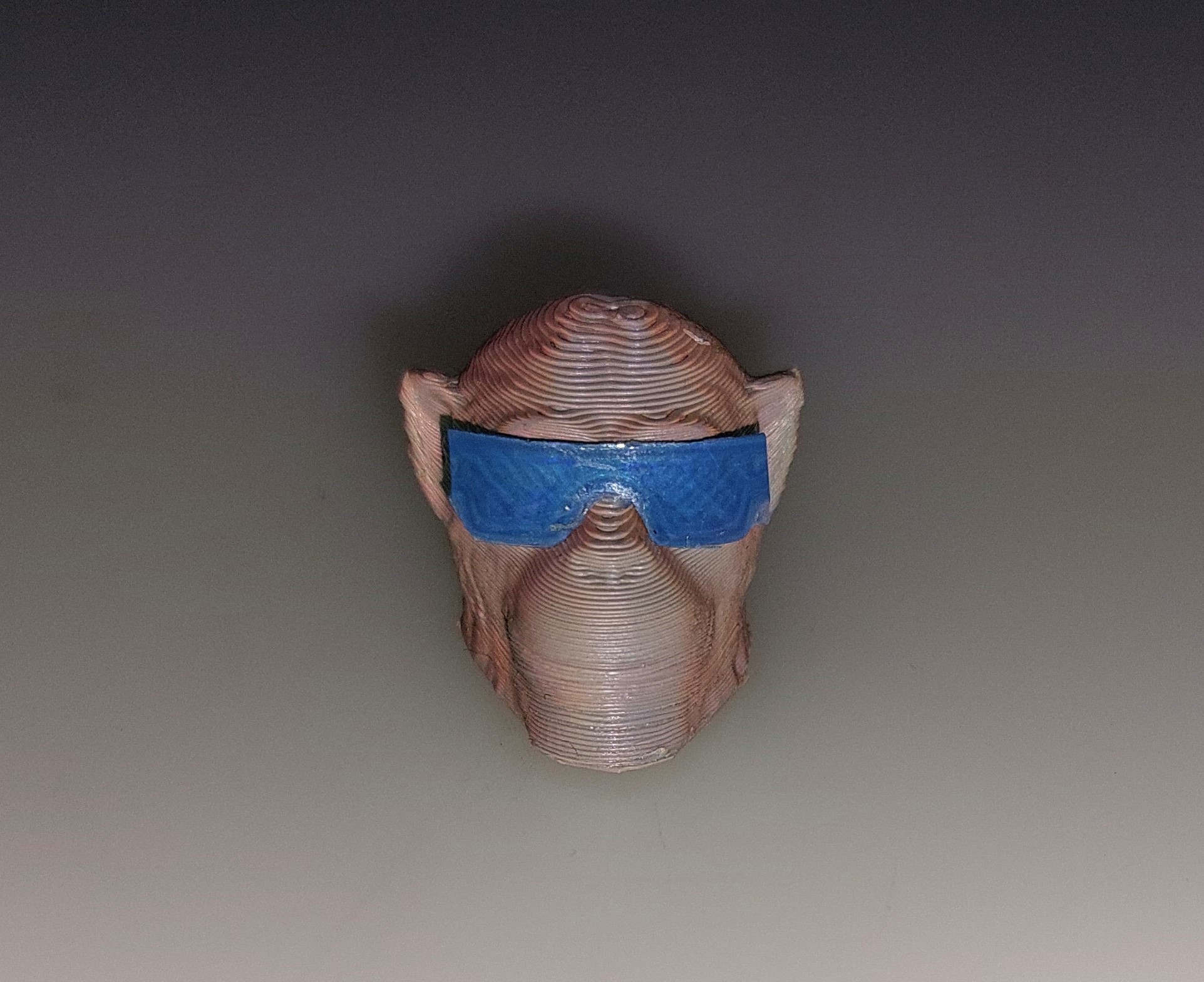
If someone has a 'hard shell but a soft centre', that's often regarded as an appealing character trait. But for Professor of Polymer Chemistry Markus Gallei and his doctoral student Lukas Siegwardt the appeal lies in creating objects called 'perfect particles' with a hard centre and a soft shell. The term 'perfect particles' is used to refer to particles that are all of identical size and shape. Siegwardt and Gallei have now modified these starting materials, which are typically made of common polymers such as polystyrene or poly(ethyl acrylates), so that they can now be processed in a 3D printer – something that has not so far been possible. Methods to artificially fabricate materials that show structural colours have been around since 2001, but have been restricted to ultrathin films, fractions of a millimetre thick. 'Conventionally, these materials have been processed in industrial presses or film rolling equipment, to produce thin polymer films that can change colour,' explained Professor Gallei. The colour of the film can be changed by numerous means, such as pulling the material, applying an electric voltage to it, changing the temperature or modifying the pH, to name but a few. 'You can essentially control the colour of the material on demand,' said Markus Gallei. The two great advantages of such structural colours are that they are completely harmless – unlike many conventional dye pigments – and that they never fade. Additionally, these materials are almost infinitely transformable, something that until recently was limited by the fact that they could only be produced as ultrathin films. If these materials could be shaped into 3D objects, they could be used in a wide range of applications, such as in anti-counterfeiting technology or as versatile measurement sensors, to name just two potential future uses. The particles can be manufactured so that they have highly specific properties, while also being easy to shape.
Lukas Siegwardt demonstrates the chameleon-like nature of the material by pulling on a printed test specimen about five centimetres in length. As he pulls, the object's colour changes progressively from red to blue. 'So you can see that this material already functions as a simple sensor that can react to tensile and compressive forces,' explained Siegwardt.
To understand the underlying chemistry, we need to go back to those 'perfect particles' of standard polymers that were mentioned earlier. These are commercially available as a white, tacky powder that is fed into an industrial press or, now more frequently, into a 3D printer. 'During the printing process, the particles arrange themselves into regular patterns and these patterns will have different colours depending on the spacing between the particles,' explained Markus Gallei. The soft shells of the individual particles melt to create a flowable mass that surrounds the hard cores. Pulling on an object changes the distances between the individual core particles and the colour changes accordingly. The hard 'perfect' particles move within the soft surrounding medium and arrange themselves into a new pattern. Markus Gallei explained this molecular-level rearrangement as being like 'squeezing honey from out between the individual particles.' Changing the distances between these minute particles changes the way the material interacts with visible light, thus changing the colours we observe.
But preparing such materials for 3D printing involved a lot of lab work for Lukas Siegwardt. "I modified the material so that it could actually be printed. It took me months to find the right composition and the right recipes,' says Siegwardt. There were two tough nuts to crack in the process. First, Siegwardt had to modify the flow properties of the powdery starting material so that the particles didn't clog the printer's nozzles and the material could be printed with as little residue as possible. 'The second issue was the material's thermal properties. In an industrial press, the starting material has to withstand about 120 °C. But in a 3D printer, the material experiences temperatures of 140 °C and sometimes as high as 200 °C,' said Siegwardt, explaining the demands placed on the material. 'Many of the materials I tested during those months were simply not up to the job,' he recalled. But his perseverance paid off and he finally found the right recipe.
Thanks to their efforts, the two research scientists from Saarland University have established a method that can be used to develop new and practical applications for these shimmering structurally coloured objects. And it's all down to a soft shell and a hard core.
Original publication (open access):
L. Siegwardt, M. Gallei*, Complex 3D-Printed Mechanochromic Materials with Iridescent
Structural Colors Based on Core–Shell Particles, Advanced Functional Materials 2023,
https://doi.org/10.1002/adfm.202213099
Further information:
Prof. Dr.-Ing. Markus Gallei
Tel.: +49 681 302-4840
Email: markus.gallei@uni-saarland.de
Web: www.gallei-lab.com
Lukas Siegwardt
Tel.: +49 681 302-2492
Email: lukas.siegwardt@uni-saarland.de
Our application for initial funding at the htw Saar on the topic of
"Development of hierarchical porous polymer membranes by means of a low‐temperature process"
was approved. The project marks the start of a new cooperation in the field of membrane technology between the Chair in Polymer Chemistry at the UdS and the Institute of Physical Process Engineering at the htw. The aim of the new project is the development and characterization of porous membranes in the ultrafiltration and microfiltration range from a low‐temperature manufacturing process that has received little attention to date. Manufacturing parameters are to be worked out in order to generate a hierarchical porous membrane structure. Subsequently, the membranes are to be used in filtration. The optimally adjusted structures should finally lead to a very low pressure loss at high flux during filtration. This should reduce the necessary pump energy and, in turn, increase the filtration efficiency.
 |
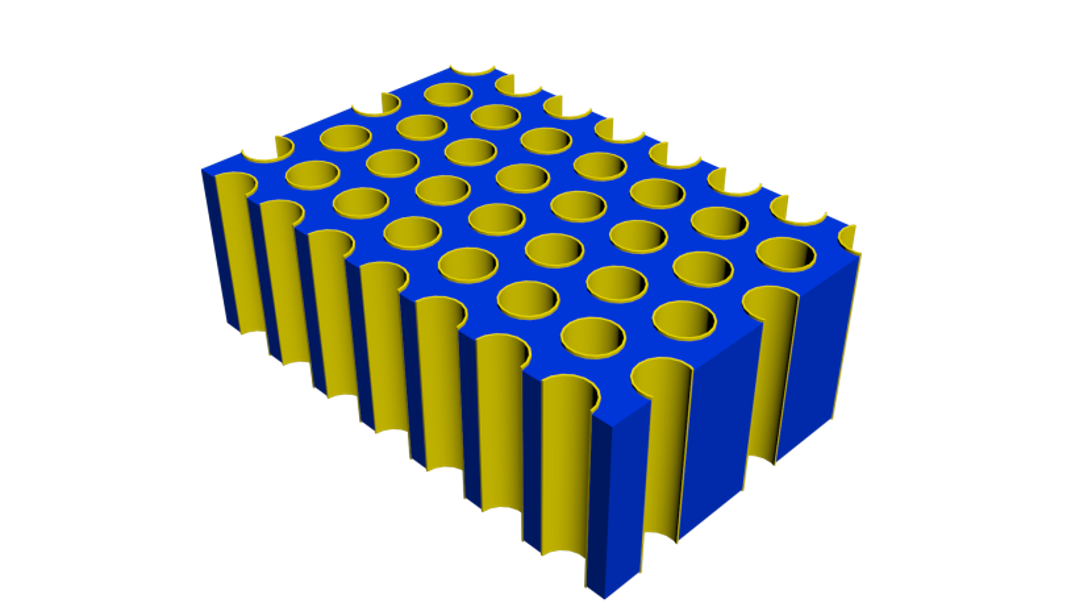 |
New Article and Frontispiece in Macromolecular Rapid Communications
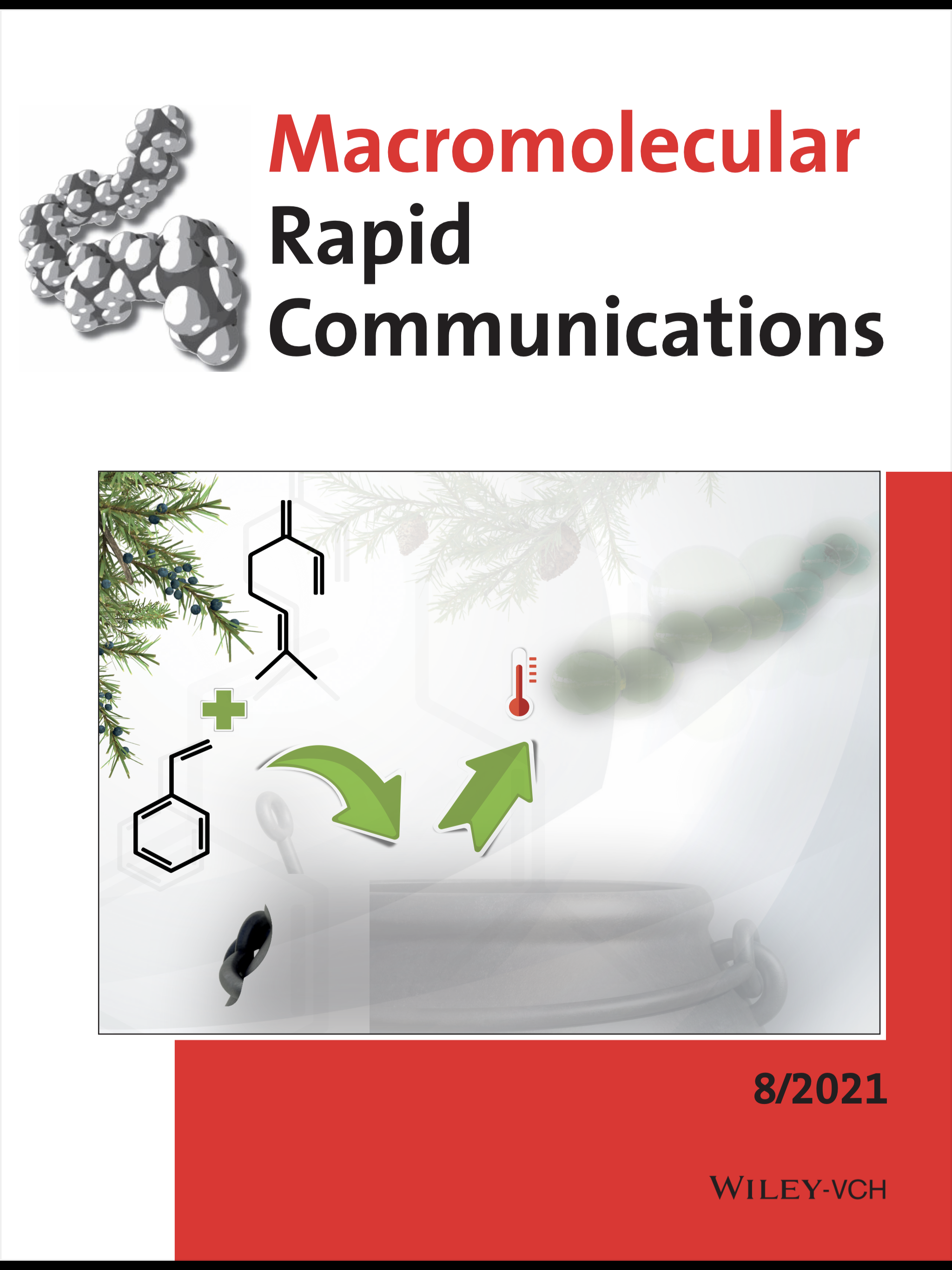
The bio‐based monomer, myrcene, attracts significant interest as a green alternative for the preparation of polydiene‐based materials and for polymer architectures. In article number
Artikel: 2000513,
Markus Gallei and co‐workers introduce a convenient statistical, i.e. one‐pot anionic copolymerization, strategy for the design of myrcene‐based block copolymer architectures.
Temperature Variation Enables the Design of Biobased Block Copolymers via One-Step Anionic Copolymerization - Bareuther - 2021 - Macromolecular Rapid Communications - Wiley Online Library https://onlinelibrary.wiley.com/doi/10.1002/macp.202170028
New Front Cover in Macromolecular Chemistry and Physik
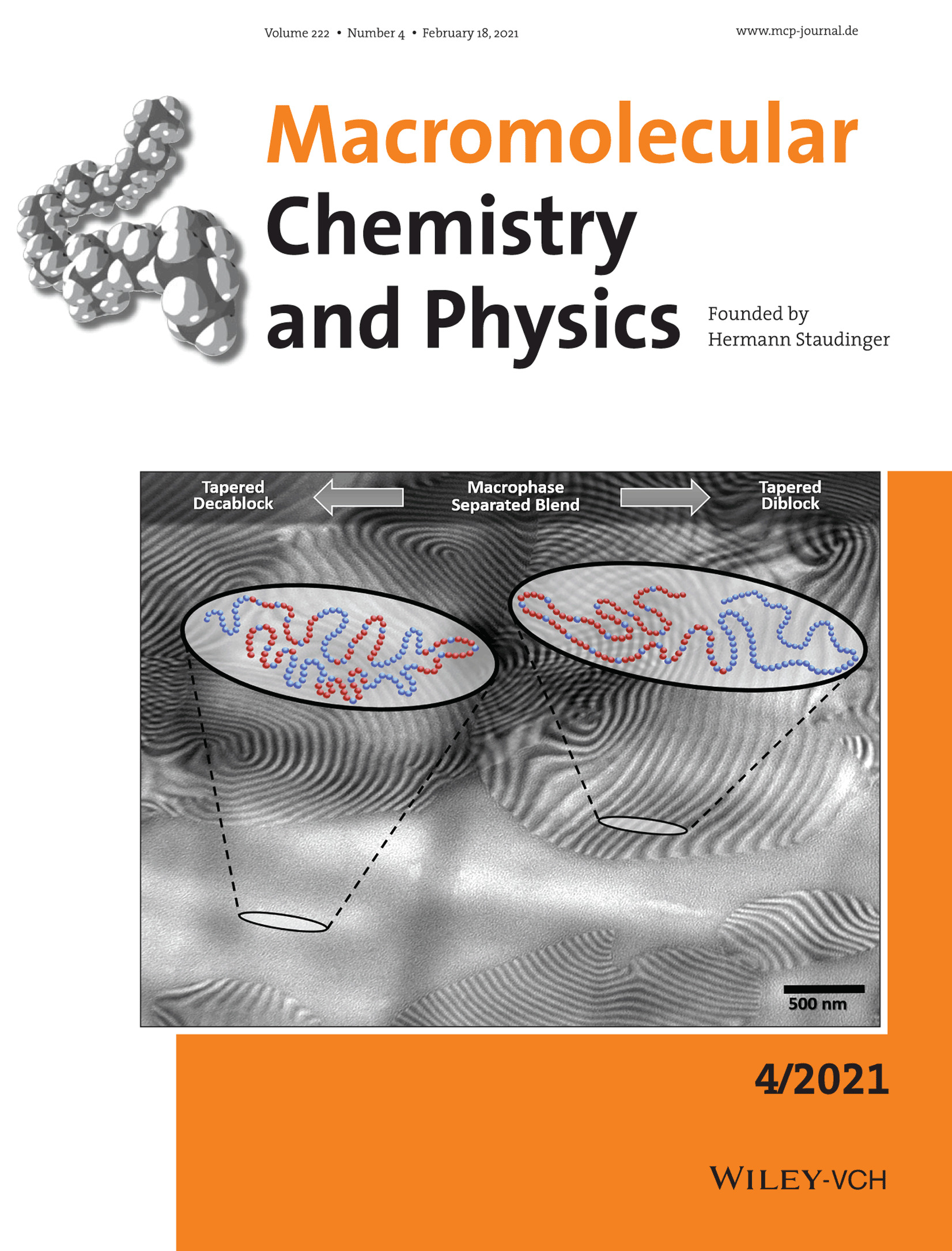
Front Cover: The poor mechanical properties of diblock copolymers can be enhanced by blending with tapered multiblock copolymers. In article number 2000373, Marvin Steube, Martina Plank, Markus Gallei, Holger Frey and George Floudas demonstrate enhanced elastic response and toughness introduced by the addition of a limited amount of a multiblock copolymer. These results may guide future industrial processes based on the synthesis of TPEs as blends of tapered diblock and multiblock copolymers with predictably mechanical properties.
Artikel: https://onlinelibrary.wiley.com/doi/10.1002/macp.202000373
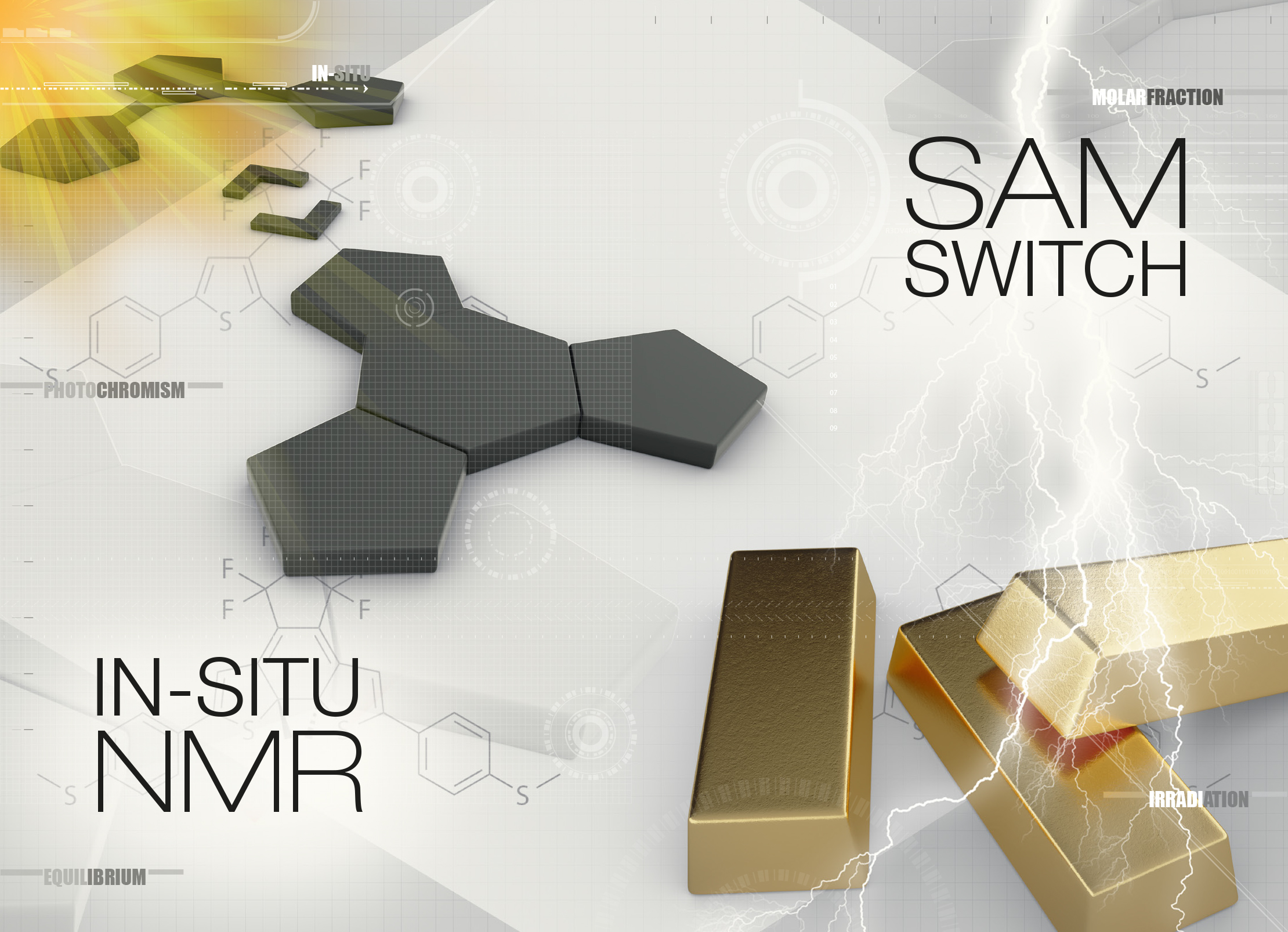
Journal of Materials Chemistry
Showcasing research from the labs of Prof. Markus Gallei, Saarland University, and Prof. Christina M. Thiele, Technische Universität Darmstadt, on stimuli-responsive materials. Photochromic dithienylethenes characterized by in situ irradiation NMR-spectroscopy and electrochemically induced responsiveness on gold substrates.
Detailed insights into the switching capabilities of dithienylethenes (DTE) can be achieved by irradiation of photochromic molecules by in situ NMR spectroscopy experiments. Chemical substitution and the electronic situation of DTE derivatives strongly affect the switching capabilities. Investigating and understanding the conversion in detail allows for the choice of feasible DTE candidates for future applications such as sensors or electrochemical devices.
See: Christina M. Thiele, Markus Gallei et al., J . Mater. Chem. C , 2019, 7, 14088.
Meet Us @ Makromolekulares Kolloquium 2020 in Freiburg
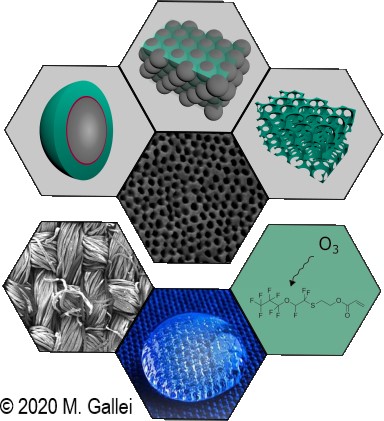
Beim diesjährigen Makromolekularen Kolloquium in Freiburg ist die Arbeitsgruppe mit einem Poster vertreten. Der Beitrag von Julia Kredel beschäftigt sich mit dem Aufbau von hochfluorierten Polymeren zum Aufbau von Kern-Schale Partikel für die Herstellung von Opalstrukturen und porösen Strukturen.
Freitag, 28.02.2020 10:30 Uhr: Poster 15
Synthesis of fluorine-containing core-shell particles for the preparation of functional opal and inverse opal architectures
J. Kredel, M. Gallei
Graduated Speaker Award
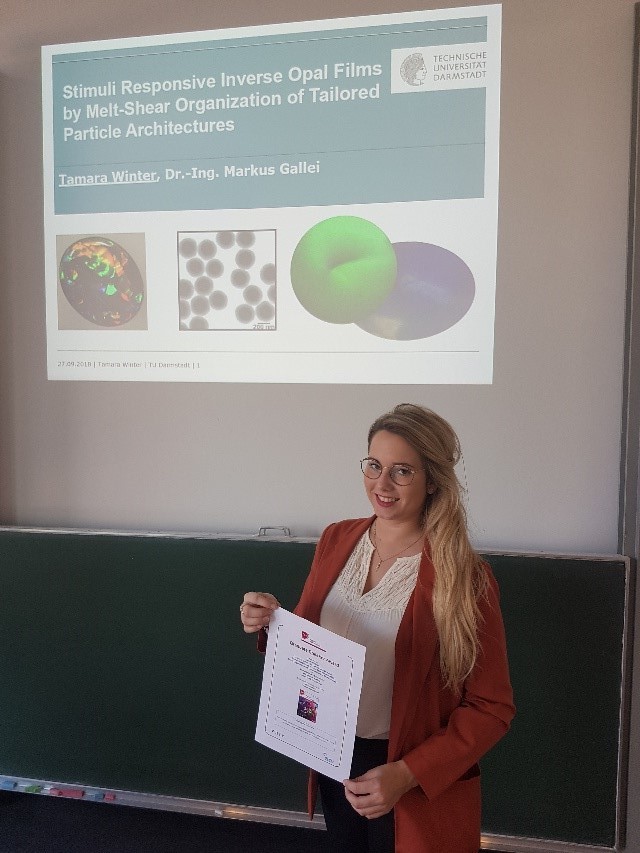
22.08.2018 – Our group was present at the 256th National Meeting & Exposition of the American Chemical Society (ACS) in Boston (Massachusetts, USA) in August 2018. The ACS, which was founded in 1876, is the largest scientific community worldwide with more than 160.000 members having an annual number of participants of 40.000 from more than 100 different countries.
This year, Ms. Tamara Winter was honoured with the Graduated Speaker Award for her presentation in the field of porous polymers entitled: „Stimuli Responsive Inverse Opal Films by Melt Shear Organization of Tailored Particle Architectures“. Within her work an efficient protocol for the synthesis of monodisperse hybrid core-shell particle architectures was presented. These materials can be advantageously used and processed to fabricate free-standing and tailored 3D porous inverse opal films. By the incorporation of smart switchable moieties, these nanostructured porous materials can be used as optical sensor devices and electrochemical adsorbents. This work, which is in close collaboration with the group of Professor T. Alan Hatton at the Massachusetts Institute of Technology, has been supported by a FiF program of the TU Darmstadt and furthermore by the LOEWE project iNAPO funded by the Ministry of Higher Education, Research and the Arts (HMWK) of the Hessen State.
Best poster price at the „Materials Science and Engineering“ (MSE) Congress in Darmstadt
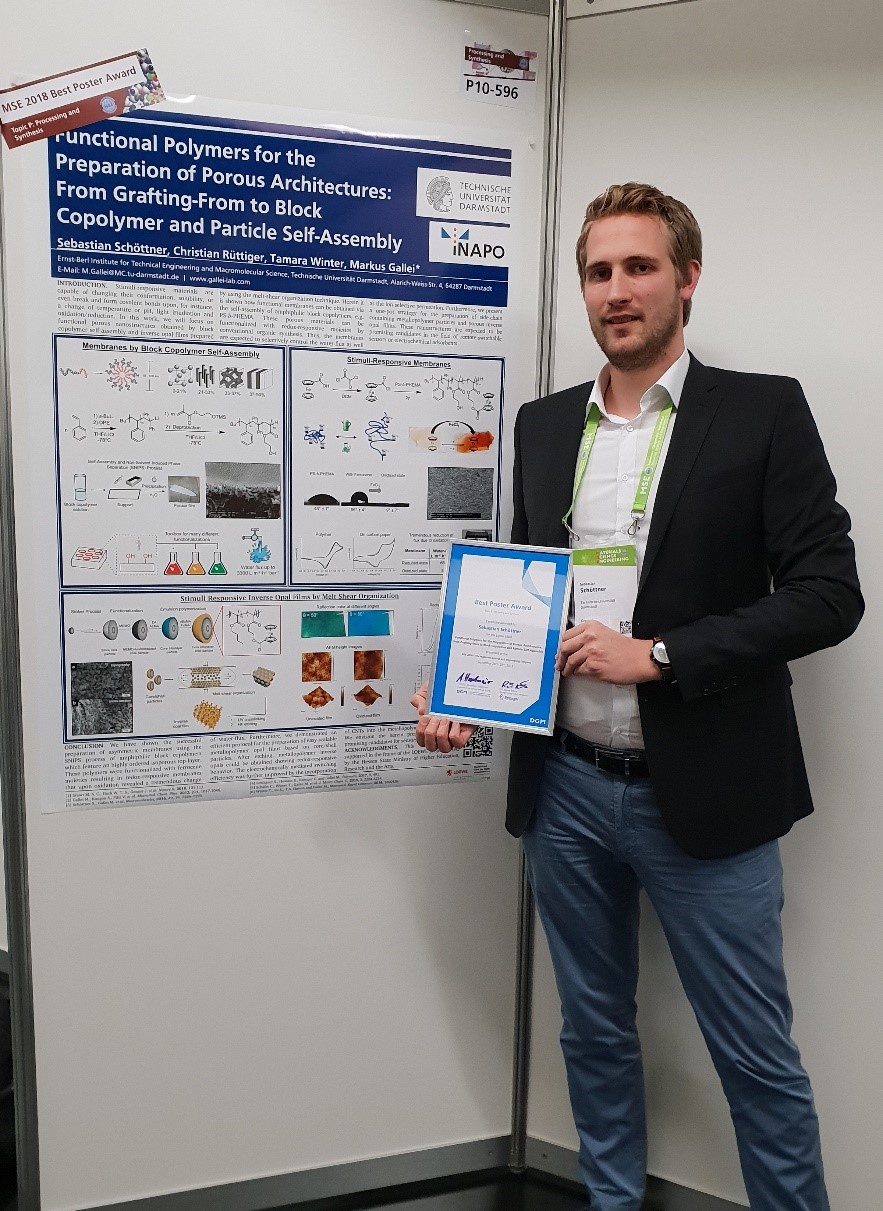
Mr. Sebastian Schöttner, PhD student in the research group of Dr.-Ing. Markus Gallei of the Macromolecular Chemistry Department, was awarded with the best poster price at the „Materials Science and Engineering“ (MSE) Congress in Darmstadt in the section “Processing and Synthesis”. The congress with around 1500 participants highlighted research areas comprising functional materials, biomaterials and processing and synthesis. Here, tailored materials featuring novel properties suitable for modern applications were of special interest. Mr. Schöttner presented the results of his PhD thesis in form of a short talk and a poster. The results were part within the LOEWE research program iNAPO (ion conductive nano pores) with the working title of his thesis “Functional Polymers for the Preparation of Porous Architectures: From Grafting-From to Block Copolymer and Particle Self-Assembly“.
Aktuelle Trends zum Design und Anwendungspotential Ferrocen-haltiger Polymere
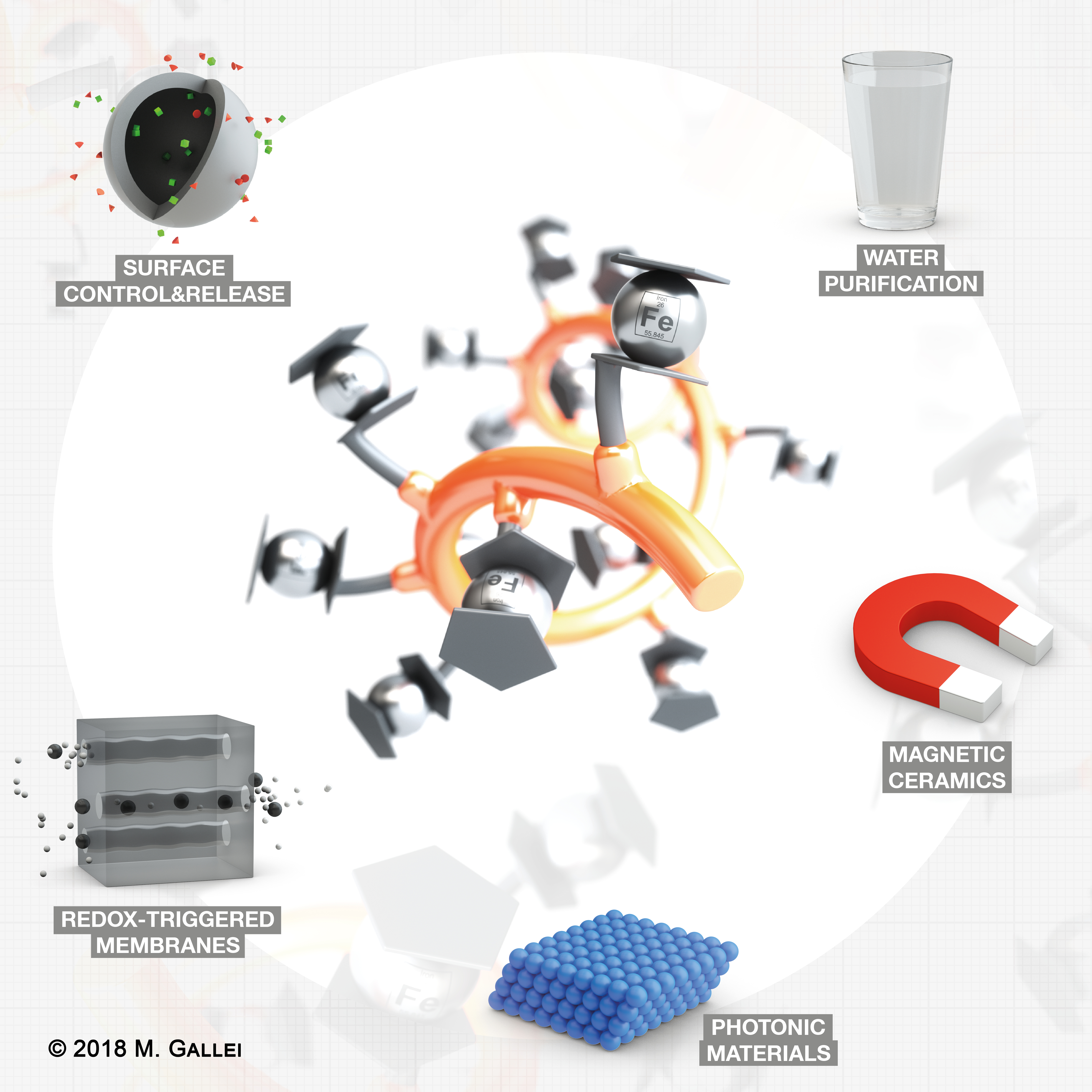
Mit der Entdeckung von Ferrocen Mitte des 20. Jahrhunderts wurde nicht nur die Metallorganischen Chemie revolutioniert. Auch mit Blick auf die Polymerwelt tragen Metallopolymere im Allgemeinen und speziell Ferrocen-haltige Polymere eine immer größer werdende Rolle. Als Hintergrund für die zunehmende Bedeutung können die mitunter redox-schaltbaren, optischen und katalytischen Eigenschaften des Ferrocens aufgeführt werden. Dabei stellt speziell die Synthese von nicht nur einfachen Homopolymeren eine teils immense Herausforderung dar. Darüber hinaus bieten Blockcoopolymere sowie oberflächenverankerte Metallopolymer-Architekturen wegen ihrer herausragende strukturbildenden Fähigkeiten auf der Nanometerskala sowohl in der Bulk-Phase wie auch in der Lösung ein außerordentliches Anwendungspotential. Hierzu zählen beispielsweise schaltbare – sogenannte smarte - Oberflächen, steuerbare Materialien zur Wirkstofffreisetzung, redox-aktive Membranen oder auch photonische Materialen.
In einem von Dr.-Ing. Markus Gallei und Christian Rüttiger kürzlich veröffentlichten Minireview werden die Herausforderungen der Synthese hin zu definierten Metallopolymerarchitekturen aufgenommen und die Realisierung mittels unterschiedlichster Polymerisationsmethoden anhand aktueller Beispiele und Errungenschaften der letzten Dekade zusammengefasst. Dabei finden speziell die kontrolliert radikalischen Polymerisationsmethoden, aber auch die „echte lebende“ anionische Polymerisation Anwendung. Über grafting-from und grafting-to Strategien werden zudem Beispiele für auf Oberflächen immobilisierte Ferrocen-haltige Polymere gezeigt, welche speziell im Hinblick auf die redox-schaltbare Benetzbarkeit an dichten Substraten, auf Partikeln oder gar in Nanoporen ein enormes Potential für neue Materialien und Anwendungen zeigen. Darüber hinaus werden die aus der gezielten Herstellung resultierender Anwendungsmöglichkeiten als redox-responsive Kolloide und Mizellen an ausgewählten Beispielen bspw. als Catch- & Release-Systeme oder für die Selbstheilung kurz diskutiert. Als besonderes Highlight werden neue Ansätze zur Wasseraufreinigung und zur selektiven Separation von Ionen basierend auf redox-steuerbaren Materialen Elektrodeenmaterialien dargestellt. Ebenfalls finden diese neuen Polymerarchitekturen Anklang als neue schaltbare photonische Materialen.
Der Review-Artikel wurde kürzlich in der renommierten Zeitschrift Chemistry – A European Journal zur Publikation angenommen:
Recent Trends in Metallopolymer Design: Redox-Controlled Surfaces, Porous Membranes, and Switchable Optical Materials Using Ferrocene-Containing Polymers - Chem. Eur. J., 2018, accepted • DOI: 10.1002/chem.201800412
Feature Article in Macromolecular Rapid Communications (Wiley VCH)
27.01.2018 — Particles Functional Polymer Opals and Porous Materials by Shear-Induced Assembly of Tailor-Made
Markus Gallei*

Photonic band-gap materials attract enormous attention as potential candidates for a steadily increasing variety of applications. Based on the preparation of easily scalable monodisperse colloids, such optically attractive photonic materials can be prepared by an inexpensive and convenient bottom-up process.
Artificial polymer opals can be prepared by shear-induced assembly of core/shell particles, yielding reversibly stretch-tunable materials with intriguing structural colors. This feature article highlights recent developments of core/shell particle design and shear-induced opal formation with focus on the combination of hard and soft materials as well as crosslinking strategies. Structure formation of opal materials relies on both the tailored core/shell architecture and the parameters for polymer processing.
The emphasis of this feature article is on elucidating the particle design and incorporation of addressable moieties, i.e., stimuli-responsive polymers as well as elaborated crosslinking strategies for the preparation of smart (inverse) opal films, inorganic/organic opals, and ceramic precursors by shear-induced ordering.
Reimund-Stadler-Preis für Markus Gallei
Dr.-Ing. Markus Gallei, Gruppenleiter in der Makromolekularen Chemie der TU Darmstadt, wurde am
26. September 2017 im Rahmen des Nachwuchswissenschaftler-Workshops der Fachgruppe Makromolekulare Chemie der Gesellschaft Deutscher Chemiker (GDCh) für den Reimund-Stadler-Preis benannt.
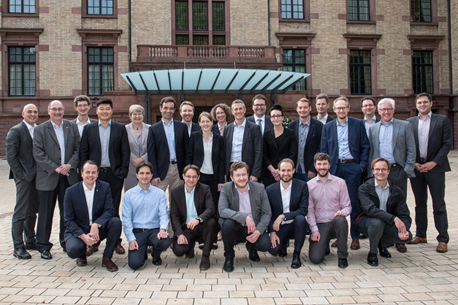
Teilnehmerinnen und Teilnehmer des Nachwuchswissenschaftler-Workshops 2017
in Ludwigshafen. Preisträger Dr.-Ing. Markus Gallei in der unteren Reihe 3. v. l.
(© Fachgruppe Makromolekulare Chemie, GDCh).
Am 25. und 26. September fand der Nachwuchswissenschaftler-Workshop der Fachgruppe Makromolekulare Chemie der GDCh bei der BASF in Ludwigshafen statt.
(Link: Hochschullehrernachwuchs-Workshop)
Dr.-Ing. Markus Gallei wurde für seine Forschung und seinen Vortrag "Porous Stimuli-Responsive Polymer Architectures as Optical Sensing Materials and Smart Membranes“ für den Reimund-Stadler-Preis 2017 nominiert. Der Preis ist mit 5.000 Euro dotiert und wird im Rahmen der Fachgruppentagung 2018 in Karlsruhe übergeben.
Neuer Artikel als Highlight bei MIT News
Der kürzlich in Kooperation mit dem Massachusetts Institute of Technology (MIT) veröffentlichte Beitrag zur Aufreinigung unseres Wassers findet auch auf der Homepage des MIT einen prominenten Platz. Ein Teil des Artikels ist ein Video, die den Aufreinigungseffekt am Beispiel eines Fluoreszenzfarbstoffes zeigt.
Eine neue Möglichkeit zur Aufreinigung unseres Wassers
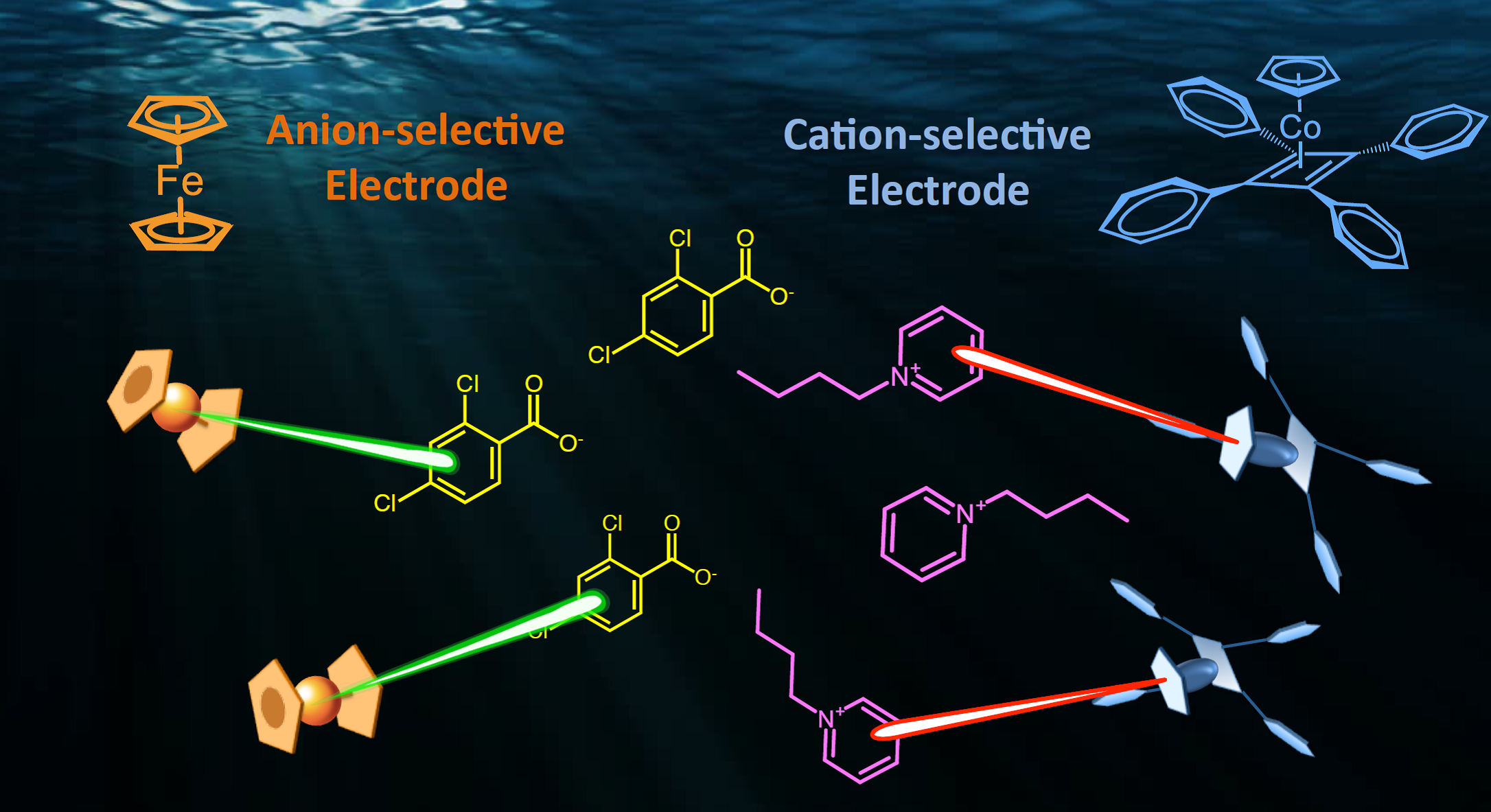
Das Auffinden neuer und verbesserter Verfahren zur selektiven Abtrennung von Verunreinigungen aus unserem Trinkwasser stellt Wissenschaftlerinnen und Wissenschaftler vor große Herausforderungen. Neue Strategien sollen dabei helfen, die immensen Kosten zur Wasseraufreinigung zu verringern. Insbesondere die selektive Entfernung von toxischen Verbindungen, pharmazeutischen Wirkstoffen oder Pflanzenschutzmitteln, stellen nach wie vor ein großes Problem aktueller Trennverfahren dar. Obwohl solche Verbindungen nur in geringen Konzentrationen auftreten, können sie – bspw. durch längerfristige Anreicherung im Körper – negative Auswirkungen auf unsere Gesundheit haben.
Trennverfahren auf elektrochemischer Basis stellen eine mögliche Alternative zu bereits bestehenden Separationssystemen dar. Insbesondere bieten sie das Potential zur deutlichen Energieeinsparung. Leider ist die bisherige Effizienz durch das Auftreten ungewollter Nebenreaktionen – insbesondere der Spaltung von Wasser in seine Elemente – begrenzt. In einer wissenschaftlichen Kooperation der Technischen Universität Darmstadt (AG von Dr.-Ing. Markus Gallei) und der Gruppe von Professor T. Alan Hatton (Massachusetts Institute of Technology) wurden erfolgreich Elektroden auf Basis von metallorganischen Polymeren entwickelt. Diese hybriden Materialien besitzen die Fähigkeit zur selektiven Abreicherung kleiner Moleküle aus Wasser bei gleichzeitiger Vermeidung der Wasserspaltung.
Dazu wurden Metallopolymere auf Basis von Ferrocen- und Cobaltocen-Derivaten genutzt, um nach elektrochemischer Reaktion gezielt Moleküle mit hoher Selektivität zu binden. Für einen effizienten Trennprozess spielt dabei aber auch die Gegenelektrode auf Basis von Cobalt-Sandwich-Verbindungen eine wichtige Rolle. Mit diesem asymmetrischen Elektroden-Setup war es möglich, gleichzeitig die Pflanzenschutzmittel Quinchlorac und Paraquat in Gegenwart eines großen Überschusses an Elektrolyt mit einer Stromausbeute von 96% zu adsorbieren. Als ein besonderes Leistungsmerkmal des gemeinsam entwickelten Konzepts konnte gezeigt werden, dass das System durch Veränderung der angelegten Spannung wieder regeneriert werden kann und es weiterhin über mehrere hundert Adsorptionszyklen stabil war. Die gemeinsame Arbeit mit den Autoren Dr. Xiao Su, Kai-Jher Tan, Dr. Johannes Elbert, Christian Rüttiger, Dr.-Ing. Markus Gallei, Professor Timothy F. Jamison und Professor T. Alan Hatton wurde kürzlich zur Publikation in der renommierten Zeitschrift Energy and Environmental Science (IF 25,4) zur Publikation angenommen. Die Arbeiten seitens der AG Gallei wurden im Zuge des LOEWE Schwerpunkts iNAPO der Technischen Universität Darmstadt durchgeführt.
Hier gelanden Sie zur Publikation in Energy and Environmental Science
Meet Us @ ACS National Meeting 2017 in San Francisco
Auf der nationalen ACS Frühjahrstagung in San Francisco wird Steffen Vowinkel seine Arbeiten aus dem Gebiet der kolloidalen Architekturen vorstellen.
Montag 03.04.2017 15:20 Uhr (Vortrag)
Stimuli-responsive colloidal architectures and porous membranes by melt-shear organization
Steffen Vowinkel, Daniel Scheid, Markus Gallei
Dienstag 04.04.2017 18:00 Uhr (Poster)
Convenient one-step preparation of isoporous nanostructures by melt-shear organization
Steffen Vowinkel, Markus Gallei
Meet Us @ Makromolekulares Kolloquium 2017 in Freiburg
Beim diesjährigen Makromolekularen Kolloquium in Freiburg hält Dr. Markus Gallei einen Vortrag über die Arbeiten aus seiner Nachwuchsgruppe. Der Vortrag wird sich um die zwei Hauptarbeitsgebiete der Blockcopolymeren und Kolloidalen Architekturen drehen.
Freitag 17.02.2017 12:15 Uhr
Stimuli-Responsive Block Copolymer and Colloidal Architectures (Vortrag)
Markus Gallei
Electrochemically-Mediated Separations by Metallopolymer/CNT Hybrid Materials (Poster)
Johannes Elbert, Xiao Su, Kai-Jher Tan, Christian Rüttiger, Markus Gallei, T. Alan Hatton
Meet Us @ DECHEMA Infotag zu Advanced Materials
Im Rahmen der DECHEMA Veranstaltung „Advanced Materials: Was können/müssen neue Prozesstechnologien beitragen?“ werden Steffen Vowinkel und Sebastian Schöttner aktuelle Arbeiten zur Herstellung hochgeordneter Membranen im Rahmen eines Postervortrags vorstellen. Die Herstellung von solchen porösen Membranstrukturen lässt sich über verschiedene Routen erreichen. Zum einen sind kolloidale Kristalle als Template für solche Strukturen geeignet. Zum anderen lassen sich hochdefinierte Blockcopolymere zur Herstellung von Membranen einsetzen.
Montag 05.12.2016 12:40
Kolloid- und Blockcopolymer-basierte Template zur Herstellung isoporöser, hochgeordneter Membranen
Steffen Vowinkel, Sebastian Schöttner, Tamara Winter und Markus Gallei
Posterpreis auf der 3. Europäischen Konferenz Smart Inorganic Materials

David Stock
Bei der 3. Europäischen Konferenz Smart Inorganic Materials (3rd EUSIP), welche vom 12. – 14.09.2016 in Porto (Portugal) stattfand, standen neue Forschungstrends im Feld hybrider organisch-anorganischer Materialien im Fokus. Die interdisziplinäre Tagung, die im Zuge des Europäischen Netzwerks „Smart Inorganic Polymers“ (COST Action CM1302) organisiert wurde, brachte internationale Forscher aus nahezu allen Disziplinen der Chemie zusammen. Im Zuge der Veranstaltung wurde Herr David Stock aus der Nachwuchsgruppe von Dr.-Ing. Markus Gallei für seinen Beitrag zu steuerbaren Metallopolymeren und „Magnetisch schaltbaren Opalen“ mit dem 1.Posterpreis ausgezeichnet. Die präsentierten Arbeiten werden im Zuge des LOEWE Schwerpunkts iNAPO der Technischen Universität Darmstadt behandelt. Weitere Autoren des Beitrags waren: Herr Dr. Daniel Scheid (TUD), Frau Tamara Winter (TUD), sowie Herr Gauvin Hemery und Dr. Olivier Sandre von der Université de Bordeaux.
Meet Us @ 3rd European Conference on Smart Inorganic Polymers
Im Rahmen der 3. Europäischen Konferenz über intelligente anorganische Polymere wird Markus Gallei über die Herstellung und Anwendung von Ferrocen-haltigen Polymeren berichten. Speziell die Immobilisierung auf Oberflächen und die Schaltbarkeit mittels Oxidation/Reduktion stehen hierbei im Fokus. Weiterhin wird David Stock über magnetische adressierbare Opal Strukturen mit einem Poster informieren.
Dienstag 13.09.16 11:10
Ferrocene-Containing Polymer Structures: Preparation, Immobilization and Applications (Vortrag)
Christian Rüttiger, David Stock, Sebastian Schöttner, Daniel Scheid, Markus Gallei*
Dienstag 13.09.16 15:20
Magnetic addressable opal structures (Poster)
David Stock, Daniel Scheid, Tamara Winter, Olivier Sandre, Markus Gallei*
Posterpreis auf der „80th Prague Meeting on Macromolecules“ Tagung in Prag
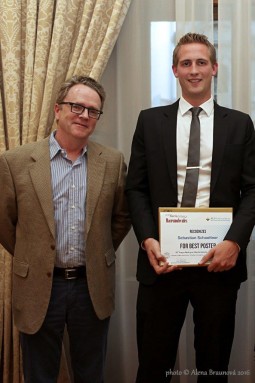
Professor Timothy P. Lodge (links) und Herr Sebastian Schöttner (rechts)
27.07.2016 — Herr Sebastian Schöttner, Doktorand in der Nachwuchsgruppe von Dr.-Ing. Markus Gallei in der Makromolekularen Chemie, erhielt bei der diesjährigen Tagung zum Thema „Self-Assembly in the World of Polymers“ in Prag den 1. Posterpreis. Der Preis wurde von Professor Timothy P. Lodge (Chief Editor ACS Macromolecules) übergeben.
Die Tagung umfasst thematisch die Strategien zur hierarchischen Strukturierung Polymer-basierter Materialien für eine Vielzahl von technischen und biologischen Anwendungen. Das Prinzip der Selbstanordnung zur Herstellung von funktionalen Strukturen auf der Nanometerskala wurde besonders hervorgehoben. Herr Schöttner präsentierte in diesem Kontext seine ersten Ergebnisse im Zuge des erfolgreichen LOEWE Schwerpunkts iNAPO (ionenleitende Nanoporen) als Poster mit dem Titel „Preparation of Porous Functional Films by Microphase Separation of Block Copolymers“.
Meet Us @ 6th International Colloid Conference
6th International Colloids Conference
01.06.2016 — Die 6. Internationale Kolloid Konferenz bringt weltweit renomierte Wissenschaftler zusammen um sich auf den Feldern der Kolloid und Oberflächenchemie über neueste Entwicklungen auszutauschen. Dr. Markus Gallei wird auf der Tagung einen Vortrag halten.
Dienstag 21.06.2016 16:50 (Salon 3):
Stimuli-responsive colloidal architectures and polymer opal films (Vortrag)
Markus Gallei*, Daniel Scheid, Christian Schäfer, David Stock, Steffen Vowinkel.
„iNAPO“ erhält Auszeichnung
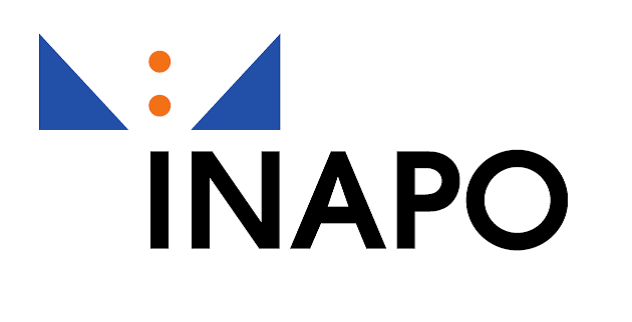
Mit dem Forschungsprogramm "iNAPO" gehört die TU Darmstadt zu den Preisträgern des Wettbewerbs "Ausgezeichnete Orte im Land der Ideen" 2016 . Die Arbeitsgruppe ist mit einem Teilprojekt durch Dr. Markus Gallei und Sebastian Schöttner an iNAPO beteiligt.
Meet Us @ Progress in Paper Physics Seminar 2016
Progress in Paper Physics Seminar 2016
27.05.2016 — Das Progress in Paper Physics Seminar 2016 findet in Darmstadt statt und bietet ein Forum für führende Experten in der Papierphysik als auch für Ingenieure aus der Industrie mit dem Interesse an neuesten Entwicklungen und Innovationen.
Dienstag 23.08.2016 15:30:
Paper-based block copolymer and functional polymer membranes (Poster) – Sebastian Schöttner, Christian Rüttiger, Heinz-Joachim Schaffrath, Markus Biesalski, Markus Gallei.
Meet Us @ Self assembly in the world of Polymers
Self assembly in the world of Polymers
27.05.2016 — Das Symposium dreht sich um die letzten Entwicklungen in der Herstellung, Charakterisierung und theoretischen Beschreibung von selbstanordnenden polymeren Systemen und ihre biologischen und technischen Anwendungen
Montag 11.07.2016 17:00 Uhr und Dienstag 12.07.2016 17:00 Uhr:
Preparation of porous functional films by microphase separation of block copolymers (Poster) – Sebastian Schöttner, Heinz-Joachim Schaffrath, Markus Gallei.
Meet Us @ LPP16
World Congress On Living Polymerizations and Polymers 2016
27.05.2016 — Bei der LPP16 (World Congress On Living Polymerizations and Polymers) in Budapest die vom 29. Mai – 3. Juni stattfindet und sich rund um das Thema lebende Polymerisationen und Polymere dreht wird der Arbeitskreis Rehahn mit folgendem Poster vertreten sein:
Dienstag 31.05.2106 17:20 Uhr:
Synthesis of Metallopolymer-Grafted Block Copolymers – Michael Appold, Christian Rüttiger, Markus Gallei.
LOEWE fördert Nachwuchs in der Chemie
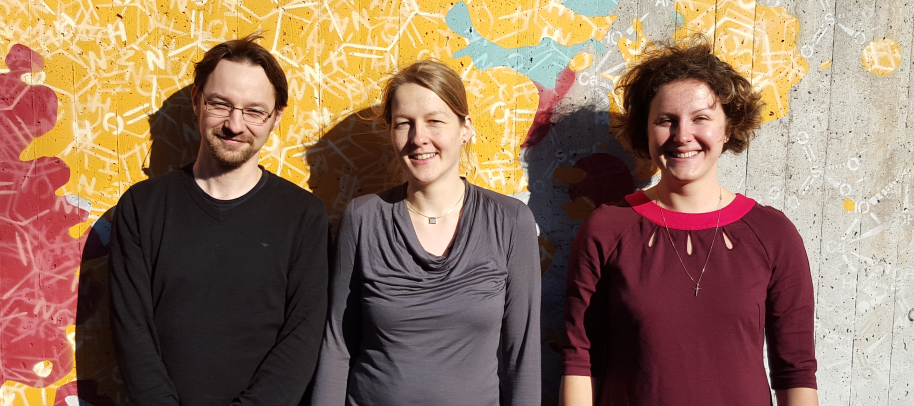
Die Chemie-Nachwuchsgruppenleiterinnen und -leiter, die im Zuge
des LOEWE iNAPO gefördert werden (v.l.: Markus Gallei,
Annette Andrieu-Brunsen und Alesia Tietze)
Natürlich vorkommende Membranen enthalten Proteine, die sehr selektiv physikalische und chemische Signale wahrnehmen und in messbare bspw. elektrische Signale umwandeln können. Im Zuge des LOEWE-Projekts „Ionenleitende Nanoporen (iNAPO)“ sollen sowohl Bau- wie auch Funktionsprinzipien biologischer Ionenkanäle verstanden werden und Wege eruiert, diese Funktionen für synthetische Ionenkanäle zu adaptieren und weiter auszubauen. Die Kopplung biologischer Nanoporen mit Kunststoff-Nanoporen soll im Zuge des seit Beginn des Jahres laufenden Verbundprojektes zu einer neuen Plattform sensorischer Devices führen, die in der Analytik und der Biomedizin zum Einsatz kommen sollen. Im Zuge des LOEWE-Projekts iNAPO werden die drei Nachwuchsgruppen von Jr.-Prof. Dr. Annette Andrieu-Brunsen, Dr. Alesia Tietze und Dr.-Ing. Markus Gallei im Fachbereich Chemie mit je einer Doktorandenstelle gefördert.

Polymer Chemistry – One for all: Cobalt-haltige Polymethacrylate
11.01.2015 — Ein neues Cobalt-haltiges Monomer wurde mittels freier und kontrollierter radikalischer Polymerisation zu Homo-, Co- und Blockcopolymeren umgesetzt.
Die erhaltenen Metallopolymere zeigen ein multi-redox responsives Verhalten und lassen sich über einen weiten Spannungsbereich elektrisch oder elektrochemisch schalten. Des Weiteren können diese Polymere als präkeramische Materialien eingesetzt werden, welche nach thermischer Behandlung zu magnetischen Cobaltoxiden umgewandelt werden können. Die erhaltenen Materialien bieten eine Plattform für selektive Freisetzungen, Nanolithography oder magnetische Bauteile auf Basis eines weichen Polymer-Templats.
One for all: cobalt-containing polymethacrylates for magnetic ceramics, block copolymerization, unexpected electrochemistry, and stimuli-responsiveness
C. Rüttiger, V. Pfeifer, V. Rittscher, D. Stock, D. Scheid, S. Vowinkel, F. Roth, H. Didzoleit, B. Stühn, J. Elbert, E. Ionescu and M. Gallei*
Special Issue „Novel Design Strategies for new functional materials“
01.12.2015 — Im Rahmen einer Sonderausgabe des Journal of Materials Chemistry C zum Thema „Novel Design strategies for new functional materials“ konnte ein Beitrag aus der Nachwuchsgruppe von Dr. Gallei eingebracht werden.
Die Arbeit konzentriert sich auf die Herstellung neuartiger 3-dimensionaler Kohlenstoffstrukturen auf Basis hybrider Polymerpartikel und den Einsatz des Schmelzscherverfahrens für hybride Systeme. Das besondere Verfahren ermöglicht eine großflächige und einfache Herstellung poröser Kohlenstoffstrukturen.
3D-Ordered Carbon Materials by Melt-Shear Organization for Tailor-Made Hybrid Core-Shell Polymer Particle Architectures
Steffen Vowinkel, Christian G. Schäfer, Gennady Cherkashinin, Claudia Fasel, Felix Roth, Na Liu, Christian Dietz, Emanuel Ionescu and Markus Gallei
Journal of Materials Chemistry C – Hot Article
24.09.2015 — Der Beitrag zu polymeren Inversopalfilmen wurde vom Journal of Materials Chemistry C in die Auswahl der „Hot Articles 2015“ aufgenommen.
In dem Artikel wird die Entwicklung einer neuen Strategie für stimuli-responsive Inversopale beschrieben. Die besonderen optischen Eigenschaften in Abhängigkeit verschiedener Stimuli eröffnet neue Möglichkeiten zur Herstellung von Sensoren.
Smart polymer inverse-opal photonic crystal films by melt-shear organization for hybrid core–shell architectures
C. G. Schäfer, T. Winter, S. Heidt, C. Dietz, T. Ding, J. J. Baumberg und M. Gallei
Meet Us @ ACS Boston
250th ACS National Meeting & Exposition:
Innovation from Discovery to Application
11.08.2015 — Bei der ACS in Boston die vom 16. – 20. August stattfindet und sich rund um das Thema Innovationen dreht wird der Arbeitskreis Rehahn mit folgenden Postern und Tagungsbeiträgen vertreten sein:
Sonntag 16.08.2015 18:00 Uhr und Montag 17.08.2015 20:00 Uhr:
Magneto-responsive hybrid colloidal architectures: Preparation, processing, and opal film formation (Poster)
– Daniel Scheid, Markus Gallei.
Eco-friendly scratch resistant wood coatings based on silica nanoparticles (Poster) – Christopher Alt, Cynthia Cordt, Roland Klein.
Mittwoch 19.08.2014 14:20 Uhr:
Introducing metal-containing monomers in emulsion polymerization for the preparation of smart stimuli-responsive polymeric opal structures (Vortrag)
– Daniel Scheid, Markus Gallei.
Das vollständige Programm findet sich hier.

